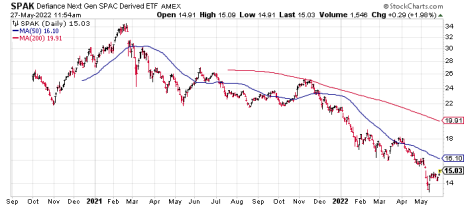If you love growth stocks, like I do, it hasn’t been a kind market of late. When the major indexes are below my favorite gauge of long-term sentiment, their 200-day moving averages, I prefer to shift primarily to cash and tighten up my stop-losses for the positions I continue to hold. The aim is to preserve capital to thrive when stocks are bullish – and history shows they are about three quarters of the time. But there is still a way to invest in growth stocks without risking your capital and it involves a deeply out-of-favor instrument right now: SPACs.
SPACs, as you’re probably aware, are special purpose acquisition companies—"blank check” businesses that raise money at an IPO with the intent of merging with another company, usually a private business that wants to go public. If you follow the market, you know SPACs were wildly bullish during the pandemic, in the same bucket as meme stocks, as companies like Virgin Galactic (SPCE), DraftKings (DKNG) and Nikola (NKLA) boomed on the long-term promise of space tourism, sports betting and electric vehicles, respectively.

Learn More

Learn More

Learn More

Learn More
SPACs Down, but Not Out
But as the chart of the first SPAC-focused ETF, the Defiance Next Gen SPAC Derived ETF (SPAK), shows the frenzy peaked in February 2021 and has burst since. The reasons: too many SPACs flooding the market place, an SEC crackdown on accounting procedures and, as with Nikola, management missteps and overly optimistic projections pitched to investors.
But SPACs are still coming to market, albeit at a slower pace: 66 have held their IPO year-to-date compared to a whopping 315 this time last year, according to data compiled by me and by SPACAlpha. They present a unique opportunity for growth seekers. Think of them like an interest-bearing CD with a free option to buy into the next wave of exciting growth companies that will come to market in the next few years.
I’m using them to add some low-risk, potential home run exposure to the portfolio of my newsletter, which invests in the sea-change of energy, mobility and consumer behavior occurring around the response to global warming. Here’s how me and my subscribers invest in SPACs.
SPACs IPO units at $10, a unit being some combination of a full share, a partial or whole warrant to buy another share at $11.50 and, sometimes, a right, which gets you a fraction of a share of the merged company, if a merger ever happens. SPACs state a timeframe they have to find a merger partner, usually between 12 and 24 months. The IPO money raised by SPAC IPOs goes into a trust fund, almost always invested in U.S. Treasury bills or equivalents with a maturity of less than 185 days. That’s as close to guaranteed capital as you can find, and it’s yours provided, like a CD, you’re willing to wait.
Typically, 52 days after an IPO the units can be split into their component shares, warrants and rights, which then trade independently on the stock market. Once a SPAC finds a business to take public, shareholders have the option at the merger vote to keep their shares in the new business, or claim the trust money back. If the merger doesn’t appeal to you (for instance, the SPAC wants to merge with a company outside its stated focus) you can swap your shares for the trust money, getting your initial investment back – and you still own the warrants and the rights!
You could sell those too, collecting a profit, or keep them and stay in the merged business. Warrants usually expire essentially worthless five years from the merger, so you have time to wait through the market cycles for a good company to prove itself. Rights don’t expire, since they convert into shares of the merged company. If the market considers the SPAC deal a slam dunk, like we’ve seen with Lucid Motors (LCID), keep the shares, warrants and rights and turbocharge your profits over the long run.
The current market weakness for SPACs means two things benefit investors now: one is SPAC units are trading at or near their IPO price after going public, which means we can scoop up units cheap; only two SPAC IPOs occurring over the past month have units now trading above $10. The other benefit is that SPAC unit terms have improved a lot. These days, the SPAC will commit more than the IPO price to the trust fund to appeal to investors: the average trust this year, according to my data, is $10.17 per share. That means you can buy SPAC units with a guaranteed return on par with T-bills or a high-yield savings account.
Even more appealing, SPACs now usually also give themselves a chance to extend their search period by three-month increments – and for each period, they’ll usually deposit another 10 cents per share into the trust. That means if the SPAC doesn’t find a deal, the trust will give back as much as $10.40 or $10.60 a share.
Why SPACs are Lower Risk
For example, a fintech-focused SPAC, Chenge Acquisition Corp (CHEAU), funded its trust at $10.30 a share at its IPO in April, and will add a dime for every three-month period it extends its search window beyond its initial 15 months, up to 24 months. Chenge traded at $10.05 recently, meaning that $10.60 trust at the end of two years would represent more than a 2.7% annual return, better than all but one two-year CD on the market, according to Bankrate data.
We’ve bought Greentech-focused SPAC units below trust value, meaning we will see risk-free returns of 7% on our money if the SPACs never find a deal up to 44% at merger time, if all goes well, with the potential for even more growth beyond that in an exciting new renewable energy, EV or environmentally friendly materials company.
SPACs do have some complexity, so you should bone up on a SPAC you’re considering by looking through its prospectus and understand what the trust amount is, the time period the SPAC gives itself and (especially) the terms on the warrants, which can vary widely and affect your ultimate profit. The best bet? Choose a SPAC you like for more than just the unit terms. With the above example of Chenge, for instance, do you ultimately want to be invested in a financial technology firm that likely will be Asia-based?
Lastly, the bear market in SPACs means most SPAC shares are trading well below trust now – and warrants and rights are quite weak too, meaning if you have to sell your shares ahead of the blank check’s deal window, you may absorb losses.
Do you own SPACs in your portfolio? How have they performed? Tell us about them in the comments below.






